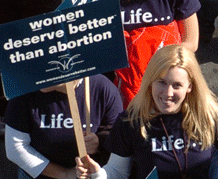The Reuters news agency is pushing a biased study claiming that abortion is safer than childbirth — a study conducted by abortion advocates and a Reuters report void of any comments or rebuttal from pro-life organizations.
The day after the March for Life, Reuters promoted a study conducted by Elizabeth Raymond and David Grimes.
“Researchers found that women were about 14 times more likely to die during or after giving birth to a live baby than to die from complications of an abortion,” Reuters reported. “Experts say the findings, though not unexpected, contradict some state laws that suggest abortions are high-risk procedures. In their report, published in the journal Obstetrics & Gynecology, Raymond and Grimes write that the findings aren’t surprising given that women are pregnant for a lot longer when they decide to have a baby and so have more time to develop complications.”
 But Paul Wilson of the Culture and Media Institute says “Reuters failed to include vital information about the study and the people it quoted – namely, that the authors of the study and both of the experts it cited were either abortion doctors or had strong ties to the abortion industry.”
But Paul Wilson of the Culture and Media Institute says “Reuters failed to include vital information about the study and the people it quoted – namely, that the authors of the study and both of the experts it cited were either abortion doctors or had strong ties to the abortion industry.”
Wilson notes: “Grimes was described by the Los Angeles Times in 1990 as “North America’s best-known researcher on RU-486, the French-made abortion drug that opponents call “the death pill,” “the chemical coat hanger,” “the human pesticide” and “the Dalkon Shield of the ’90s.” Grimes also protested against restrictions on partial birth abortion in 2007.”
“Raymond works for Gynuity Health Projects, which states that it “works globally to ensure that reproductive health technologies are available at reasonable cost.” Raymond’s bio notes that she considers abortion to be a “centerpiece of health issues for women,'” he indicates. “In other words, avowed pro-abortion advocates did the study. How surprising it turned out favorable to abortion.”
Wilson also says the two so-called “outside experts” Reuters used to verify the study also have abortion ties.
“Anna Davis, who was described as a doctor “who studies obstetrics and gynecology at the Columbia University Medical Center in New York,” writes for the pro-abortion blog RH Reality Check – and is a former board member of the pro-abortion supporting Physicians for Reproductive Choice and Health. And Bryna Harwood, the other expert quoted by Reuters, was associated with the same group as Davis, and is an abortion doctor herself,” Wilson said. “Needless to say, pro-life sources were nowhere to be found in the Reuters article.”
But other studies show childbirth is safer than abortion and Evangeline Jones of Americans United for Life says, “Recent analyses of large medical databases that link to death certificates (“record linkage studies”) show that pregnancy-associated deaths are between two and four times higher for women who abort than for women who deliver.”
She noted, “These studies represent, according to one researcher, “the best available medical evidence on the issue,” in contrast to “prior comparisons of mortality rates…crudely constructed on the basis of an incomplete and inaccurate reporting system.” For example, deaths from abortion often go unreported to cover up the abortion or, perhaps, the abortionist. Substitute terms, such as “uncontrolled hemorrhage,” might be listed as the cause of death.”
In late 2009, the World Economic Forum issued its annual Gender Gap Report.
According to its data, maternal mortality is lower in nations with pro-life laws restricting abortions. Countries with permissive abortion law have higher maternal death rates. Ireland, which has constitutional protection for the unborn, has the lowest maternal mortality rate in Europe: 1 maternal death per 100,000 live births.
Poland, another country with restrictive laws on abortion, has 8 maternal deaths per 100,000 live births. In contrast, the United States, with permissive laws on abortion, has 11 maternal deaths per 100,000 live births. Figures for other areas in the world confirmed the pattern: countries with the most restrictive abortion laws had the lowest maternal morality rates.
In early 2010, a study in Chile shows that bans on abortion do not increase maternal deaths. Their research found that maternal mortality peaked in Chile in 1961, at a time when abortion was legal. Abortions caused 34 percent of maternal deaths that year. In contrast, in 2007, after Chile banned abortion, maternal mortality rates had been lowered 97.9 percent.
Hence, greater access to abortion does not result in lower maternal mortality. The “reproductive justice movement” fails to realize this in its demand for cheaper and more convenient abortion service.
“Real reproductive justice calls for full disclosure. In addition to comparative mortality figures, other risks of abortion must be made known: increased risks of pre-term births and placenta previa; increased incidence of depression, suicide, substance abuse, and psychiatric admission; loss of the protective effect of a first full term pregnancy against breast cancer; and increased risk of death and injury from violent assaults,” Jones concludes. “Real reproductive justice relies on accurate, up-to-date, and complete information about all the risks of abortion and childbirth.”







